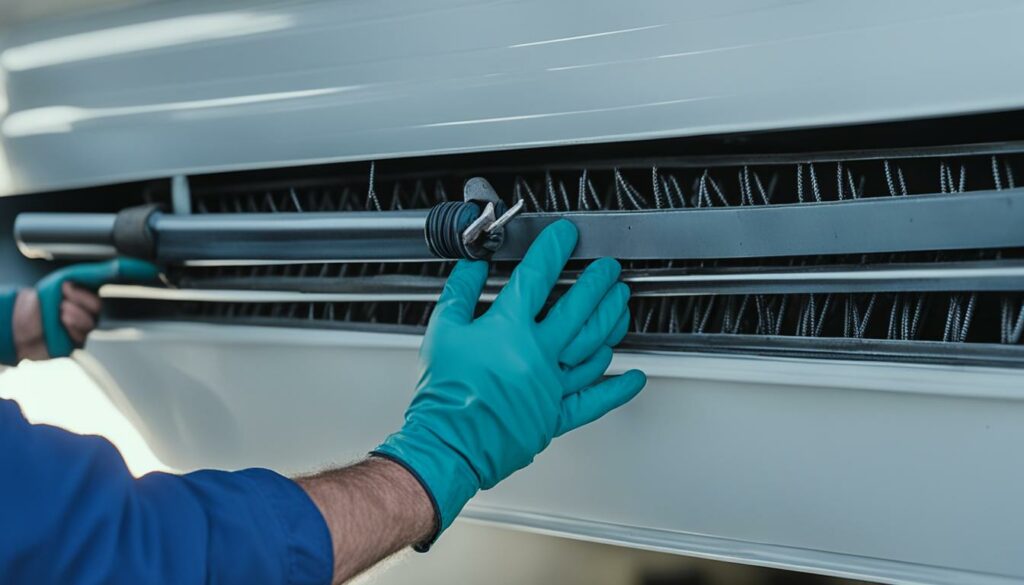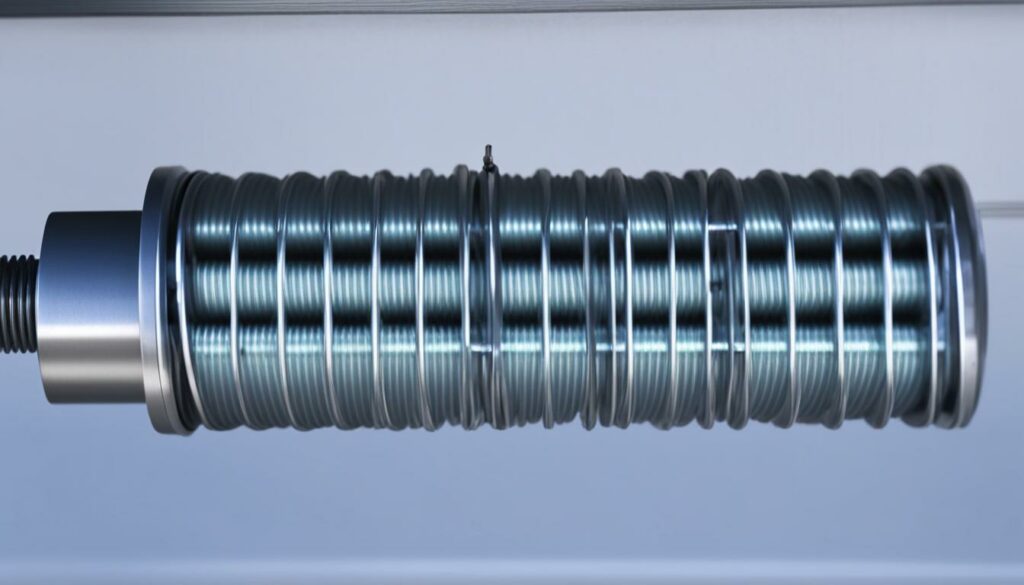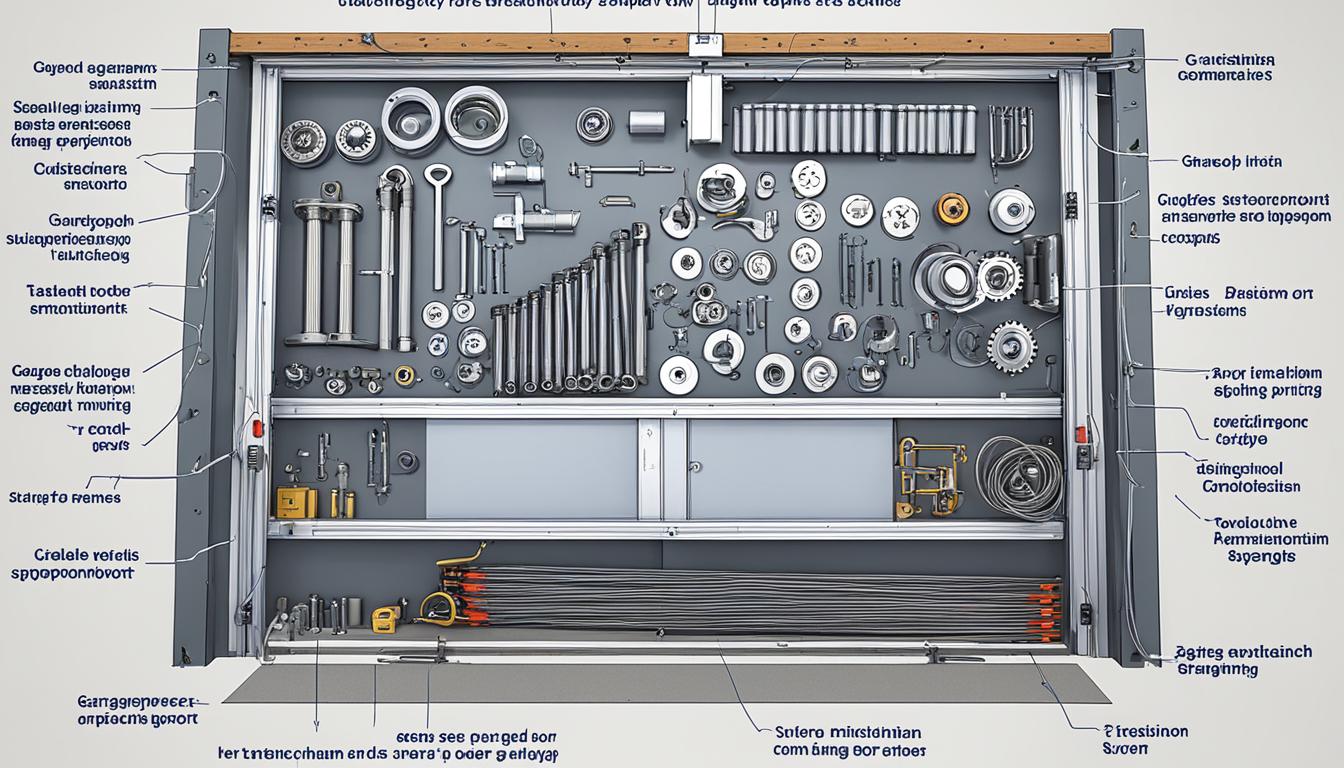Did you know torsion springs have been around since medieval times? Back then, people used them in catapults. Now, they are key in garage doors, lifting heavy weights efficiently. They’re better and last longer than the old extension springs.
The garage door spring mechanism is crucial for a garage door that moves smoothly. These springs are made of strong steel coils. They produce torque that balances the door’s weight. Positioned above the door, they wind and unwind to move the door evenly. This also makes the garage door quicker to open or close. It means less wear on the opener, saving money on repairs.
Key Takeaways
- Torsion springs have been used since medieval times in catapults and are now central to modern garage door systems.
- These springs handle garage doors weighing from 250 to 600 pounds with efficiency and longevity.
- Torsion springs generate torque, counterbalancing the door’s weight for smoother operation.
- They exert a more uniform force, relieving stress on the garage door opener and reducing future repair costs.
- Durable and dependable, torsion springs outlast older extension spring systems, making them a preferred choice for homeowners.
Introduction to Garage Door Springs
It’s important to know about garage door spring types to understand their role. There are mainly two types: torsion springs and extension springs. Each has its own way of working, affecting the garage door spring installation process.
Torsion springs have been used since old times, like in catapults. They’re set above the garage door on torsion bars. They’re known for making doors open and close smoothly. This kind of spring evens out movement to cut down stress. Thus, torsion springs help avoid many future repairs. They’re part of a complex setup, including parts like bearing plates.
On the other hand, extension springs stretch out and contract as the door moves. They’re cheaper to install than torsion springs. But, they might cost more to keep up. Swapping extension springs for torsion springs could mean better performance and fewer repair bills later.
Choosing garage door spring installation wisely can lead to benefits like longer life. Torsion springs usually last longer than extension ones. They’re often seen as more dependable by many homeowners. Still, both kinds help the garage door work well and safely.
| Spring Type | Benefits | Considerations |
|---|---|---|
| Torsion Springs | Uniform motion, longer lifespan, reduced maintenance | Complex installation, requires careful handling |
| Extension Springs | Lower initial cost, simple design | Higher maintenance cost, less smooth operation |
Homeowners should know about different designs in these categories. Several torsion springs types are made for certain uses. You can find Standard Residential, Commercial, and EZ-SET types. Extension springs also come in various setups, like sectional and one-piece designs.
Knowing about each garage door spring type helps people choose the right garage door spring installation. Making a good choice can mean a longer-lasting and reliable garage door system.
For more information about how garage door springs work, including repair services and maintenance tips, visit our page on garage door repairs in Murrumba Downs.
Types of Garage Door Springs

Knowing the types of garage door springs is key for garage door spring replacement. It’s also important for understanding how does a garage door spring work. These parts are critical for balancing the garage door’s weight, ranging from 250 to 600 pounds.
Torsion Springs
Torsion springs are most often used and are known for their long-lasting service. They help lift heavy doors by unwinding. This process makes use of stored tension. Located above the door, they are safer due to fewer exposed parts. Although they cost more at the start, they are more durable than other types. Impact Doors Service offers Maxlife torsion springs. They have a 4.8-star rating on Google with over 4,756 reviews. Because they deal with heavy weights, it’s wise to let professionals handle garage door spring replacement.
| Spring Type | Features |
|---|---|
| Torsion Springs | Located above the door, safer with fewer exposed parts, last longer, higher initial cost, used for heavy doors. |
| Extension Springs | Fitted to sides of the door, lower cost, used in low headroom situations, more exposed parts. |
Extension Springs
Extension springs work by contracting to lift the door. They’re suited for places with low headroom. These springs are attached to the door’s sides. They’re cheaper than torsion springs. Because they’re less expensive, they’re commonly used in new homes. But, they do have more exposed parts, which can be risky. People often choose them when saving money is important. Still, knowing how does a garage door spring work helps in making good choices. It’s best to talk to a professional for safe garage door spring replacement.
How Does a Garage Door Spring Work?

To get why garage door springs are key, let’s peek into their workings. Garage doors use torsion and extension springs. Each has its own way of helping lift heavy doors made of various materials.
The Role of Torsion Springs
Torsion springs are crucial since they use torque for door lifting. Positioned above the door, they wind and unwind during operation. This action stores energy that later lifts the door.
By providing torque, torsion springs ensure doors open smoothly and quickly. This minimises strain on the opener. Compared to extension springs, torsion springs help save on wear and repair costs. They are also quieter and help in cost-saving over time by reducing the need for repairs.
The Role of Extension Springs
Extension springs stretch and contract, helping to balance the door’s weight. They work with pulleys and cables. Although not as efficient as torsion springs, they still are important. Mounted on each door side, they extend when the door closes. This action, over time, can cause wear and potential breakage.
Knowing the pros and cons of both spring types is essential for homeowners. Extension springs are cheaper and easier to install but wear out quicker. On the other hand, torsion springs offer better longevity and safety. They are less likely to turn into projectiles if snapped. Regular maintenance can increase their lifespan and reliability.
How to tell if a garage door spring is broken?
Knowing when a garage door spring is broken is very important. Garage door springs are under a lot of tension. They can become dangerous if they are not looked after. Look for these signs:
- Unusual noises: A loud bang, like a gunshot, means a torsion spring may have snapped.
- Inconsistent movement: If the door moves oddly or unevenly, the spring’s tension might be off.
- Failure to open: The door not opening, even with the emergency release, points to a broken spring.
- Rapid falling: A quickly falling door after lifting is a sign of spring failure.
- Manual lifting difficulty: Feeling the door is too heavy when lifting by hand means the spring is damaged.
It’s crucial to take care of garage door springs. Regular checks, oiling, and fixing them fast helps them last longer. This makes your garage door safer. Not doing this can cause a lot of damage. This could be expensive to fix.
In 2014, the U.S. Consumer Products Safety Commission noted around 18,000 injuries from garage doors. Keeping an eye on your garage door’s condition is key. Springs usually last for 10,000 to 20,000 cycles. But, with the right care, they can last even longer.
| Spring Type | Lifespan (years) | Inspection Frequency | Lubrication Frequency |
|---|---|---|---|
| Torsion Springs | 7-12 | Monthly | Twice a year |
| Extension Springs | 3-5 | Monthly | Twice a year or more in humid areas |
Looking after your garage door springs properly ensures they work well and safely. Choosing good quality parts and help is wise. It’s a good move for any house owner.
What is the average life of a garage door spring?
The average garage door spring life relies on a few things. This includes the type of spring, how often it’s used, and care. Most springs last for about 10,000 cycles. That’s around 7 to 10 years for most homes. But, this can change with daily use and care.
Looking after your garage door spring helps it last longer. Check them 3 to 4 times a year. Also, make sure they are well-oiled. Torsion springs, which are very tough, can last 14 to 20 years if you look after them. Standard springs might last just 18 months with lots of use.
- Standard manufacturer springs: ~5,000 cycles
- Oil-tempered springs: ~10,000 cycles
- Impact Doors Service MaxLife springs: ~80,000 cycles
When picking springs, think about their IPPT based on your garage door’s weight. Choose quality products for a longer life. MaxLife springs by Impact Doors Service last for 80,000 cycles. That’s more than 22 years! They’re made in the USA and have a red powder-coat finish.
If one spring breaks, experts say to replace both. This keeps your garage door working well. Pros use special tools and knowledge to fix things right. This can help your springs last even longer.
Importance of Regular Maintenance
Garage door spring maintenance keeps your door working well and safely. By doing regular checks, you can avoid big repair bills. It also makes sure the springs work for a long time.
Keeping these springs in good shape stops accidents. If a spring breaks, it could hurt someone or damage your home. Springs that are looked after well also make less noise.
If your garage door moves slowly, clean and oil the springs. This stops rust and keeps the door moving easily. If you’re unsure, ask a pro to check the springs for you.
Experts say you should check your garage door springs once a year. Not looking after them can make them rust and break. Keeping them in good shape also uses less energy.
If you ignore maintenance, springs can break and cause the door to fall. Not doing regular checks can also wear out the motor faster. This means your garage door opener won’t last as long.
Torsion springs are strong and above the door but cost more. Extension springs sit on each side of the door. Using the right oil on the springs is very important. Also, keep the area around your door clean to avoid extra wear on the springs.
| Maintenance Task | Frequency | Benefits |
|---|---|---|
| Spring Lubrication | Every 3-4 months | Prevents rust, smoother operation |
| Visual Inspection | Monthly | Identifies wear and tear early |
| Professional Inspection | Annually | Ensures safety and longevity |
| Cleaning Debris | Every 2-3 months | Prevents unnecessary wear |
Conclusion
It’s key to understand how garage door springs work. They’re crucial for your door’s smooth operation. You should know the difference between torsion and extension springs.
Getting a pro to install your springs is essential. They make sure everything works well and safely. Torsion springs can last for about 10,000 uses. High-quality springs and pro installation mean less repairs and a longer-lasting door.
The cost to replace torsion springs is between $50 and $150. Adding the cost of pro installation, the total can be $150 to $300 or more. This seems like a lot, but it saves you money on repairs later. Since most garage doors are used about 1,500 times a year, it’s smart to hire a pro for spring repair. This keeps your door safe and working right.
Keep your garage door springs in good shape with regular checks. No matter the spring type, get a pro to look at them once a year. They can spot issues like noise, sagging, or unevenness. These signs mean you might need new springs. Regular care and pro help keep your garage door running smoothly.
Garage Door Spring Repair Near You
For expert assistance with garage door spring repairs, don’t hesitate to contact Jarred at Impact Doors. Our skilled technicians are ready to help you with all your repair needs. Reach out to us today at (07) 5451 4022 to ensure your garage door operates smoothly and safely.

